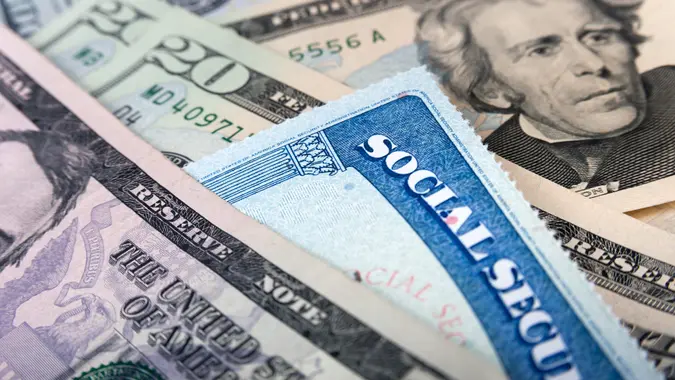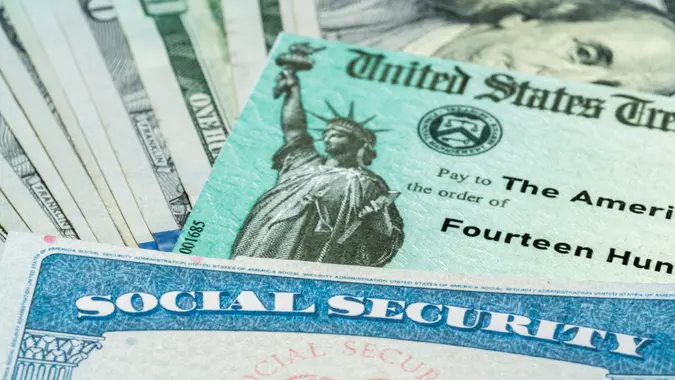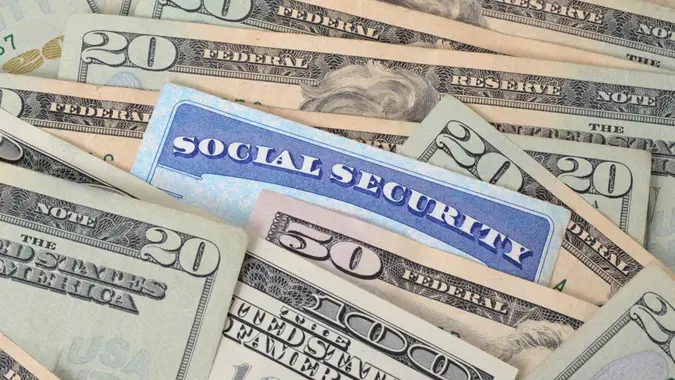I’m a Retirement Planner: What Social Security Could Look Like In a Decade If Trump Wins In November

Commitment to Our Readers
GOBankingRates' editorial team is committed to bringing you unbiased reviews and information. We use data-driven methodologies to evaluate financial products and services - our reviews and ratings are not influenced by advertisers. You can read more about our editorial guidelines and our products and services review methodology.

20 Years
Helping You Live Richer

Reviewed
by Experts

Trusted by
Millions of Readers
It remains unclear exactly what former President Trump might do with Social Security if elected this November.
However, based on his party affiliation, his first administration’s tax cuts, and other factors, here are three potential long-term changes to Social Security if Trump is elected — and how to prepare for them — according to experts.
Privatization of Social Security
Many have suggested, including Politico’s Natalie Allison, that certain Republican officials eventually aim to privatize Social Security. So, if Trump is elected in November, and is backed by a Republican House and Senate, privatizing Social Security could well be on the table — at least according to Chuck Warren, political economist and host of the “Breaking Battlegrounds” Politics Podcast.
If privatization is accomplished, Social Security could look fundamentally different in a decade, said Peter McClosky**, CEO of a health consultation and planning organization. Basically, it would mean workers having more control over their money and retirement investments.
However, said McClosky, that also means they take on more risk.
“This could involve an earlier start and more strategic retirement savings for younger people, while those nearing retirement age would have to be more conservative and diversified in investment strategies to avoid risks,” he said.
It also leaves open the question of what happens to those who don’t save responsibly, or lose their investments through no fault of their own? Who pays if they age out of the workforce? After all, the entire point of Social Security has always been as a safety net for elderly.
Reduced Funding and More Borrowing
While advocates tout that privatizing Social Security would give future retirees control — and potentially higher returns on their retirement investments — others say it would bankrupt the system sooner and increase the national debt.
Studies by the Brookings Institute showed that privatizing even 1% of payroll taxes in 1998, when the privatization proposal was pushed, would have bankrupted Social Security by 2015. This, or more robust plans, would require new taxes — which are unlikely with a Trump presidency, per McClosky — or a “slash” in benefits to younger workers.
Raise Eligibility Age
Because something must be done — and Trump and the Republicans are unlikely to raise taxes, or raise the taxable income cap to include wealthier workers — experts said that one strong possibility would be to raise the minimum age for benefits eligibility.
“They could push back the full retirement age for those under 50 years of age by a few years with very little political fallout,” said Ben Lies, president and chief investment officer at Delphi Advisers, LLC.
For example, for any American 49 years old or less at the time of the law going into effect, the full retirement age might be changed to 70 or 72, rather than 66 to 67. “This would not be a standalone solution because other things would need to be done in the near term to shore up funding for current retirees, but it would help secure the future, in combination with other actions,” said Lies.
So, What Should You Do?
If you are nearing retirement age, there is likely not much you can do. That said, your Social Security payments are likely safe, since experts say it’s political suicide to renege on them.
If you are young, however, take action now. That was the advice from each expert. “Younger people, however, should be planning to get Social Security later in life, which means they will likely need to work a bit longer or build a larger pool of assets to bridge the income gap from retirement to Social Security,” said Lies.
McClosky agreed, adding that it’s vitally important to begin saving early and diversify. The future is not certain, especially when it comes to Social Security.
“For younger clients, the emphasis on the importance of saving early and utilizing employer-sponsored retirement plans will provide a huge advantage,” said McClosky.
Further, he said those in their mid-career should constantly assess their retirement savings so they can adjust their retirement strategies as economic and political landscapes change.
**Names in this article have been changed for privacy.
Editor’s note on election coverage: GOBankingRates is nonpartisan and strives to cover all aspects of the economy objectively and present balanced reports on politically focused finance stories. For more coverage on this topic, please check out 5 Changes That Could Be Coming to Social Security if Kamala Harris Wins the Election.
 Written by
Written by  Edited by
Edited by 
























